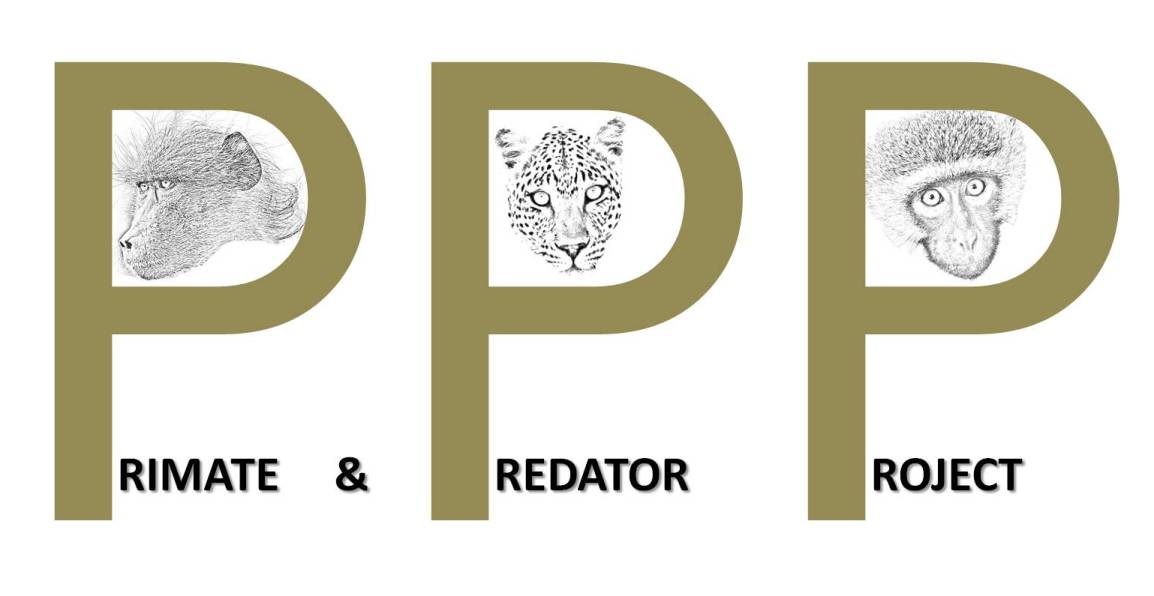Predators
Go to:
Return to:
Department of Anthropology
Durham University
Dawson Building
South Road
Durham DH1 3LE
UK
Tel: +44 (0) 191 334 1601
Fax: +44 (0) 191 334 1614
[email protected]
Last updated
15th January 2021

The micro-habitats of the Soutpansberg mountain range are home to highly diverse animal communities, with over 60% of of mammal species found in South Africa recorded in the mountains with an an especially rich carnivore community. Large carnivore species that range in the mountains are leopard (Panthera pardus), brown hyaena (Hyaena brunnea) and spotted hyaena (Crocuta crocuta), with leopards particularly abundant around Lajuma. Smaller carnivore species include African civet (Civettictis civetta), common genet (Genetta genetta), aardwolf (Proteles cristatus), honey badger (Mellivora capensis), caracal (Felis caracal), African wildcat (Felis silvestris), serval (Leptailurus serval), Cape clawless otter (Aonyx capensis) and several mongoose species; water mongoose (Atilax paludinosus). dwarf mongoose (Helogale parvula), slender mongoose (Galerella sanguinea) and banded mongoose (Mungos mungo). Cheetah (Acinonyx jubatus) are no longer found on the mountain plateau and lions (Panthera leo) only remain in the far eastern part of the Soutpansberg (Gaigher & Suart 2003).
The Soutpansberg mountain range also hosts 56% of South Africa’s bird species, including a large diversity of birds of prey. Of particular interest are crowned eagle (Stephanoaetus coronatus), Verreaux’s eagle (Aquila verreauxii) and Verreaux’s eagle owl (Bubo lacteus) since all are confirmed or potential predators of primates in our study area.
Our current and future carnivore work predominantly focusses on the following species.
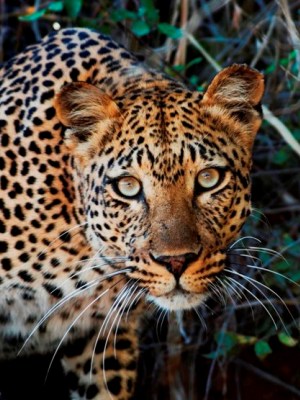 |
Leopard Panthera pardus Leopards (Panthera pardus) have the largest distribution of any wild felid, occurring widely in eastern and central Africa, although populations are declining and fragmented outside of sub-Saharan Africa. Within sub-Saharan Africa, the species is still numerous and even thriving in marginal habitats where other large cats have disappeared. Nevertheless, because of its declining range and population, leopards are listed as “Near Threatened” by the IUCN. Leopards have a broad habitat tolerance and in Africa they are most successful in woodland, grassland savanna and forest, but also occur widely in mountain habitats, coastal scrub, swampy areas, shrubland, semi-desert and desert. Leopards are elusive, solitary and largely nocturnal, and male territories are generally larger than those of females. They are versatile, opportunistic hunters, and have a very broad diet. Leopards feed on anything from dung beetles to male giant elands (900kg). Their diet consists mostly of ungulates and monkeys, but they also eat rodents, reptiles, amphibians, insects, birds, and fish. Leopards hunt by stalking, and in Africa mid-sized antelopes provide a majority of their prey. Densities vary with habitat, prey availability, and degree of threat, from fewer than one per 100 km² to over 30 per 100 km². The Soutpansberg supports one of the highest densties of leopards recorded anywhere in Africa. |
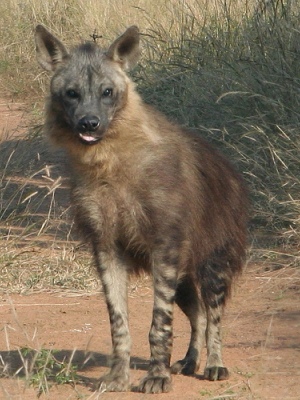 |
Brown hyaena Hyaena brunnea Brown hyaena (Hyaena brunnea) are endemic to southern Africa, aqlthough their distribution is fragmented across their range. Brown hyaenas are found in the drier areas and savannahs where they can survive with very little water; often areas with less than 100mm of annual rainfall, although they may inhabit woodland savannah with a maximum annual rainfall of 650mm. They regularly use rocky areas for shelter and dens. Brown hyenas are smaller than spotted hyaenas with an adult body weight of approximately 40kg, and little difference in size between the sexes. Brown hyena are primarily a scavenger of mammal remains, but their diet has also been found to include insects, birds, eggs and fruit. Hunting comprises a relatively small proportion of the brown hyaena’s foraging behaviour, but small mammals and birds are occasionally predated, although they are not thought to be a major threat to livestock. Brown hyaenas live in small social groups called clans which range in size from a solitary female and her cubs to groups containing several females and their offspring of different ages. Adult males either remain with their natal clan, become nomadic, or immigrate into a new clan. The clan cooperatively defends a territory, but its members of a clan forage on their own. Much of the communication among brown hyaenas, from greetings to territorial markings involves use of chemical signals. |
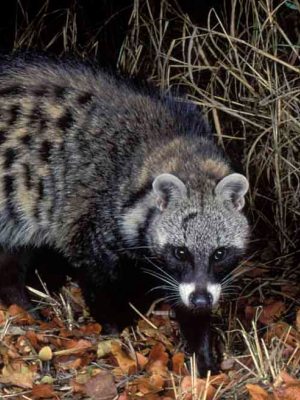 |
African Civet Civettictis civetta The African Civet (Civettictis civetta) is the largest representative of the African Viverridae (weight range 9-15kg) and the sole member of its genus. African civets are widely distributed across sub-Saharan Africa and are found in a wide variety of habitats from thick forest to open country. They are primarily nocturnal and spend the day sleeping in dense vegetation, becoming active at night. The African civet is a solitary mammal that is easily recognizable by its unique coloration; the black and white stripes and blotches covering the coarse pelage of the animal are extremely variable and allow it to be cryptic. Thes civets are omnivorous generalists, taking small vertebrates, invertebrates, eggs, carrion, and vegetable matter. They are also capable of taking on poisonous invertebrates (such as the millipedes most other species avoid) and snakes. Prey is primarily detected by smell and sound rather than by sight. Like all civets the African civet has perineal glands that produce a fluid known as civetone, which it spreads on markers in its territory to claim its range. |
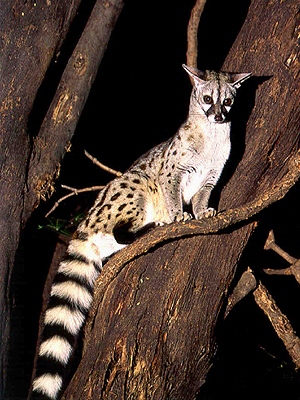 |
Common Genet Genetta genetta The Common Genet (Genetta genetta), is the most widely distributed of the fourteen species of genet, with a natural range across Africa and parts of the Middle East. A secretive, nocturnal species, the common genet inhabits rocky terrain with caves, dense scrubland, pine forests, and marshland. The species has a pale grey and black spotted coat, with a long striped tail. Like all genets, it has a small head, large ears and eyes, and short legs with retractable claws. Common genets weighs between 1.5 and 2.5kg and males are larger than females. They are excellent climbers although much of their foraging is done on the ground. Common genets has a varied diet, that consists of small mammals, lizards, birds, amphibians, insects and fruit.
|
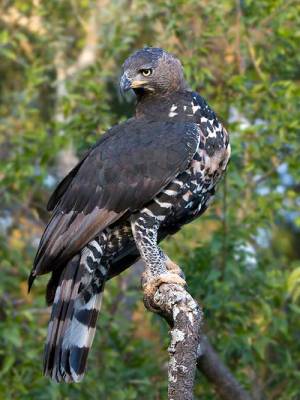 |
African Crowned Eagle Stephanoaetus coronatus The African crowned eagle (Stephanoaetus coronatus), is a very large (wingspan 1.5-1.8 metres), powerful, crested bird of prey found in sub-Saharan Africa. It inhabits dense forests, heavily wooded hillsides, dense woodland and rocky outcrops, although owing to lack of suitable habitat, the eagle’s range is discontinuous across its distribution. The crowned eagle is non-migratory and is largely sedentary, usually inhabiting a fixed territory for most of its lifespan. Crowned eagle pairs breed once every two years (a single breeding cycle is approximately 500 days) and build massive nests in a fork of large, emergent trees. The nest may be re-used during successive breeding seasons. The crowned eagle’s staple diet is mostly mammalian, with primates being the most commonly taken prey. In suitable habitat it will also take hyraxes and small antelope such as duikers. Typically, the eagle can carry a mass roughly equal to its own (~ 3–6 kg) to its nest or perch; anything heavier is dismembered and returned to the nest or perch in pieces. Parts of larger prey are often cached for later consumption. |
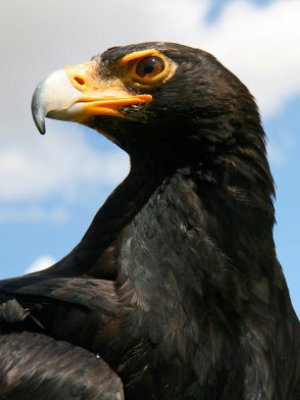 |
Verreaux’s Eagle Aquila verreauxii Verreaux’s eagle (Aquila verreauxii), sometimes known as the black eagle, inhabits hilly and mountaineous regions of southern and eastern Africa. It is a large eagle with a wingspan of up to 2.2 metres, and an average weight for males of 3.7 kg and 4.5 kg for females. It is black with a distinct white V marking on its back, while juveniles are usually light and dark brown with a black face. Verreaux’s eagle are highly territorial and can often be seen with a mate since the birds are thought to mate for life. Verreaux’s eagle specialist hunters of hyraxes (or dassies), and the size of their territory is generally inversely proportional to the size of the local hyrax population. Occasionally, however, these eagles will prey on birds such as guineafowl or mammals of similar size to hyraxes, such as large rodents or primates. |
Reference:
Gaigher, I.G. & Stuart, C.T. 2003. Mammals. In: Berger, K., Crafford, J.E., Gaigher, I., Gaigher, M.J., Hahn, N. & Macdonald, I. (eds.) A first synthesis of the environmental, biological and cultural assets of the Soutpansberg. Leach Printers & Signs, Louis Trichardt, South Africa

